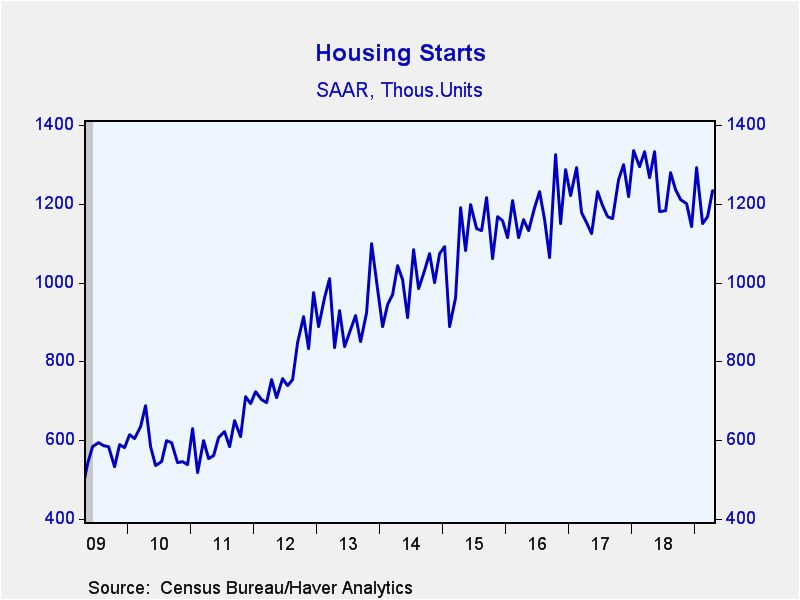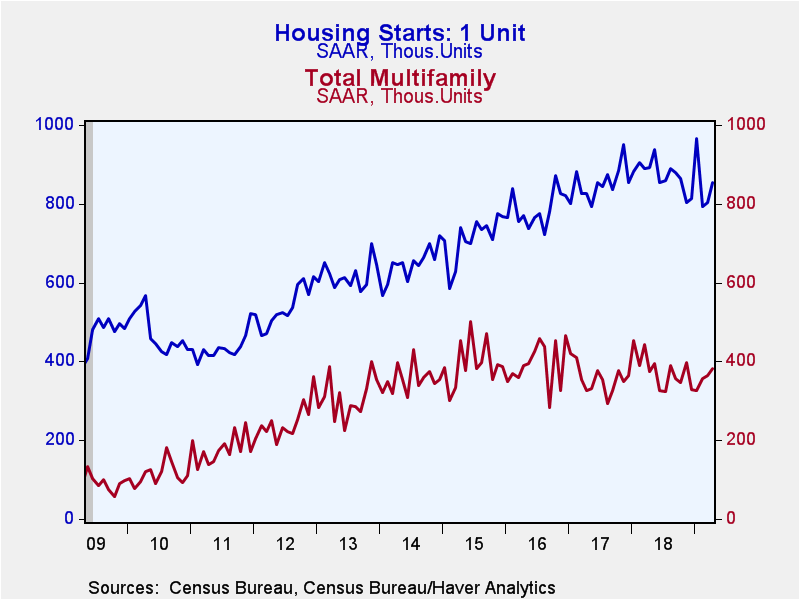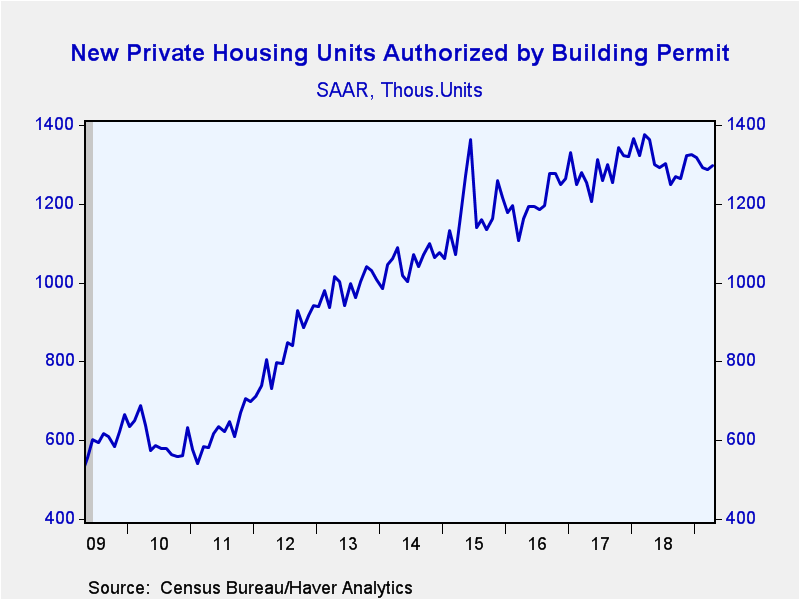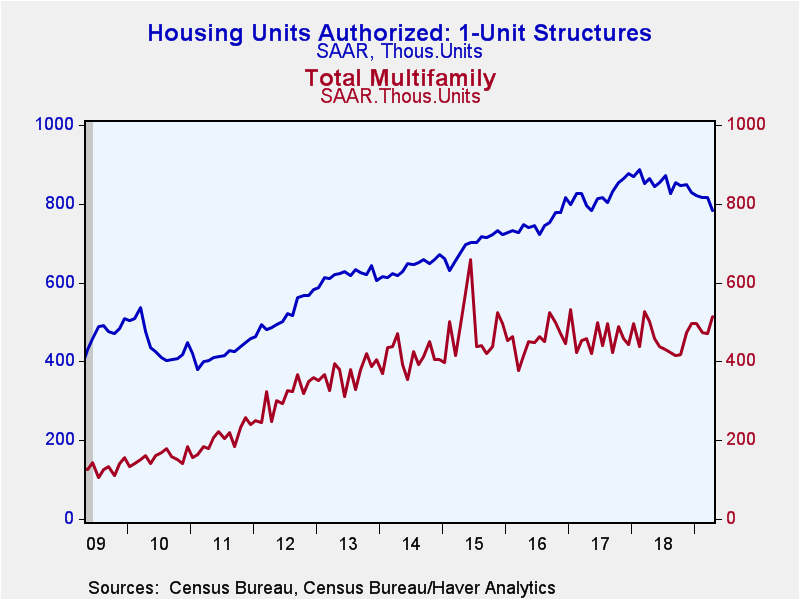 Global| May 16 2019
Global| May 16 2019U.S. Housing Starts Post a Solid Increase
by:Tom Moeller
|in:Economy in Brief
Summary
Housing starts rose 5.7% during April to 1.235 million units (SAAR) following a March improvement to 1.168 million units, revised from a slight m/m decline. Despite the latest increase, housing starts were 2.5% lower than one year [...]
Housing starts rose 5.7% during April to 1.235 million units (SAAR) following a March improvement to 1.168 million units, revised from a slight m/m decline. Despite the latest increase, housing starts were 2.5% lower than one year earlier. The Action Economics Forecast Survey expected 1.215 million starts.
Starts of single-family homes strengthened 6.2% (-4.3% y/y) to 854,000 last month from 804,000 in March, revised from 785,000. Multi-family housing starts rose 4.7% (1.6% y/y) to 381,000 units, the highest level since November.
The increase in housing starts last month reflected mixed performance across the country. In the Northeast, starts surged 84.6% (48.5% y/y) to 144,000 units. The increase reversed sharp declines during the prior two months. In the Midwest, starts also were strong and posted a 42.0% rise (17.0% y/y) to 186,000, a six-month high. Working lower was the level of housing starts in the South. They declined 5.7% (-12.2% y/y) to 581,000, off for the third straight month to the lowest level since September. Housing starts in the West also weakened 5.5% (-7.2% y/y) to 324,000 after rising by roughly one-third m/m during March.
Building permits improved 0.6% last month (-5.0% y/y) to 1.296 million following three straight monthly declines. Permits to build a single-family home fell 4.2% (-9.4% y/y) to 782,000, the lowest level since November 2016. Multi-family building permits recovered 8.9% (2.6% y/y) to 514,000, the highest level since March of last year.
The housing starts and permits figures can be found in Haver's USECON database. The expectations figure is contained in the AS1REPNA database.
The Risk of Returning to the Zero Lower Bound from the Federal Reserve Bank of San Francisco is available here.
| Housing Starts (000s, SAAR) | Apr | Mar | Feb | Apr Y/Y % | 2018 | 2017 | 2016 |
|---|---|---|---|---|---|---|---|
| Total | 1,235 | 1,168 | 1,149 | -2.5 | 1,250 | 1,209 | 1,178 |
| Single-Family | 854 | 804 | 792 | -4.3 | 873 | 852 | 786 |
| Multi-Family | 381 | 364 | 357 | 1.6 | 377 | 357 | 392 |
| Starts By Region | |||||||
| Northeast | 144 | 78 | 89 | 48.5 | 111 | 111 | 116 |
| Midwest | 186 | 131 | 159 | 17.0 | 171 | 180 | 185 |
| South | 581 | 616 | 650 | -12.2 | 631 | 603 | 585 |
| West | 324 | 343 | 251 | -7.2 | 336 | 314 | 292 |
| Building Permits | 1,296 | 1,288 | 1,291 | -5.0 | 1,313 | 1,286 | 1,206 |
Tom Moeller
AuthorMore in Author Profile »Prior to joining Haver Analytics in 2000, Mr. Moeller worked as the Economist at Chancellor Capital Management from 1985 to 1999. There, he developed comprehensive economic forecasts and interpreted economic data for equity and fixed income portfolio managers. Also at Chancellor, Mr. Moeller worked as an equity analyst and was responsible for researching and rating companies in the economically sensitive automobile and housing industries for investment in Chancellor’s equity portfolio. Prior to joining Chancellor, Mr. Moeller was an Economist at Citibank from 1979 to 1984. He also analyzed pricing behavior in the metals industry for the Council on Wage and Price Stability in Washington, D.C. In 1999, Mr. Moeller received the award for most accurate forecast from the Forecasters' Club of New York. From 1990 to 1992 he was President of the New York Association for Business Economists. Mr. Moeller earned an M.B.A. in Finance from Fordham University, where he graduated in 1987. He holds a Bachelor of Arts in Economics from George Washington University.










